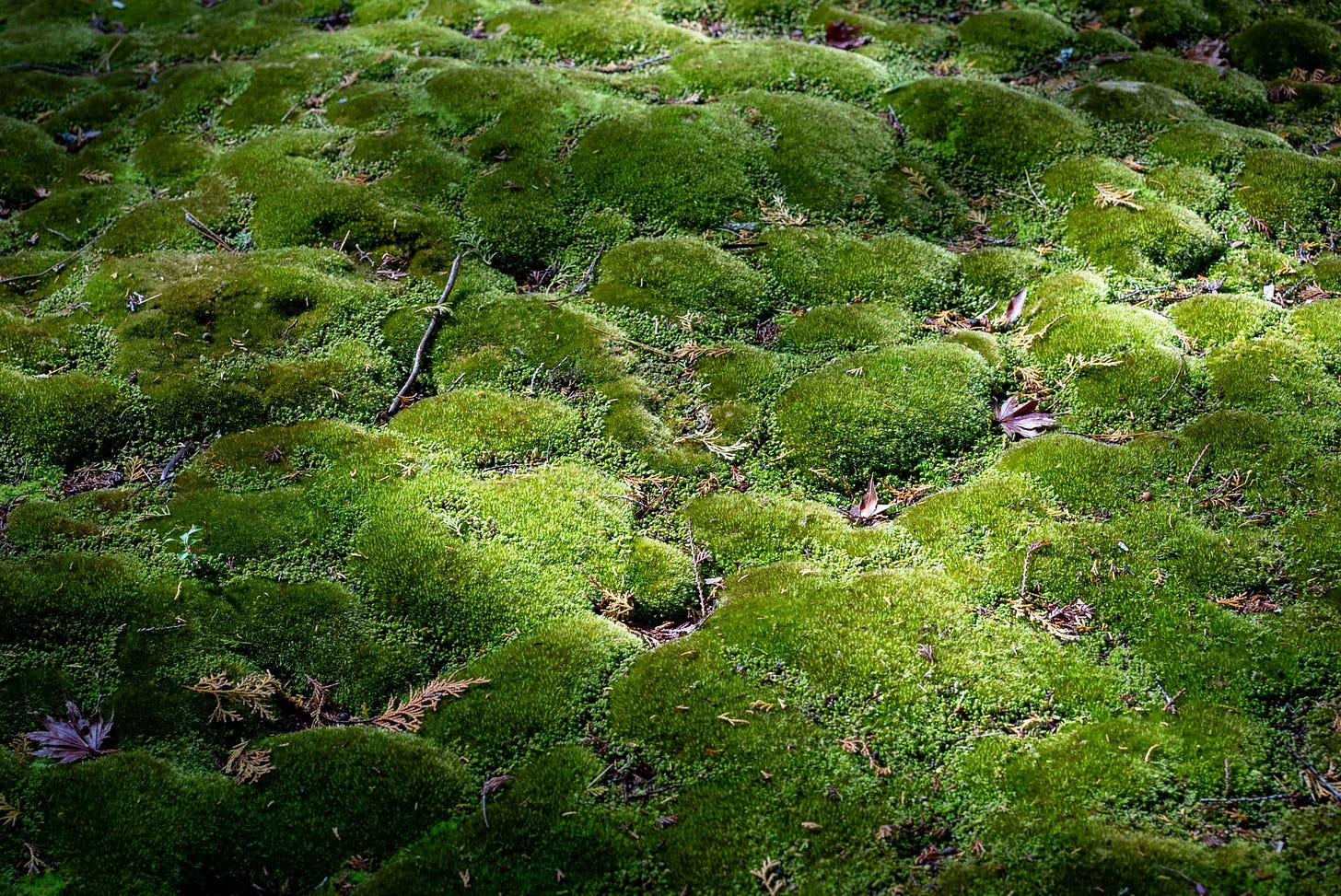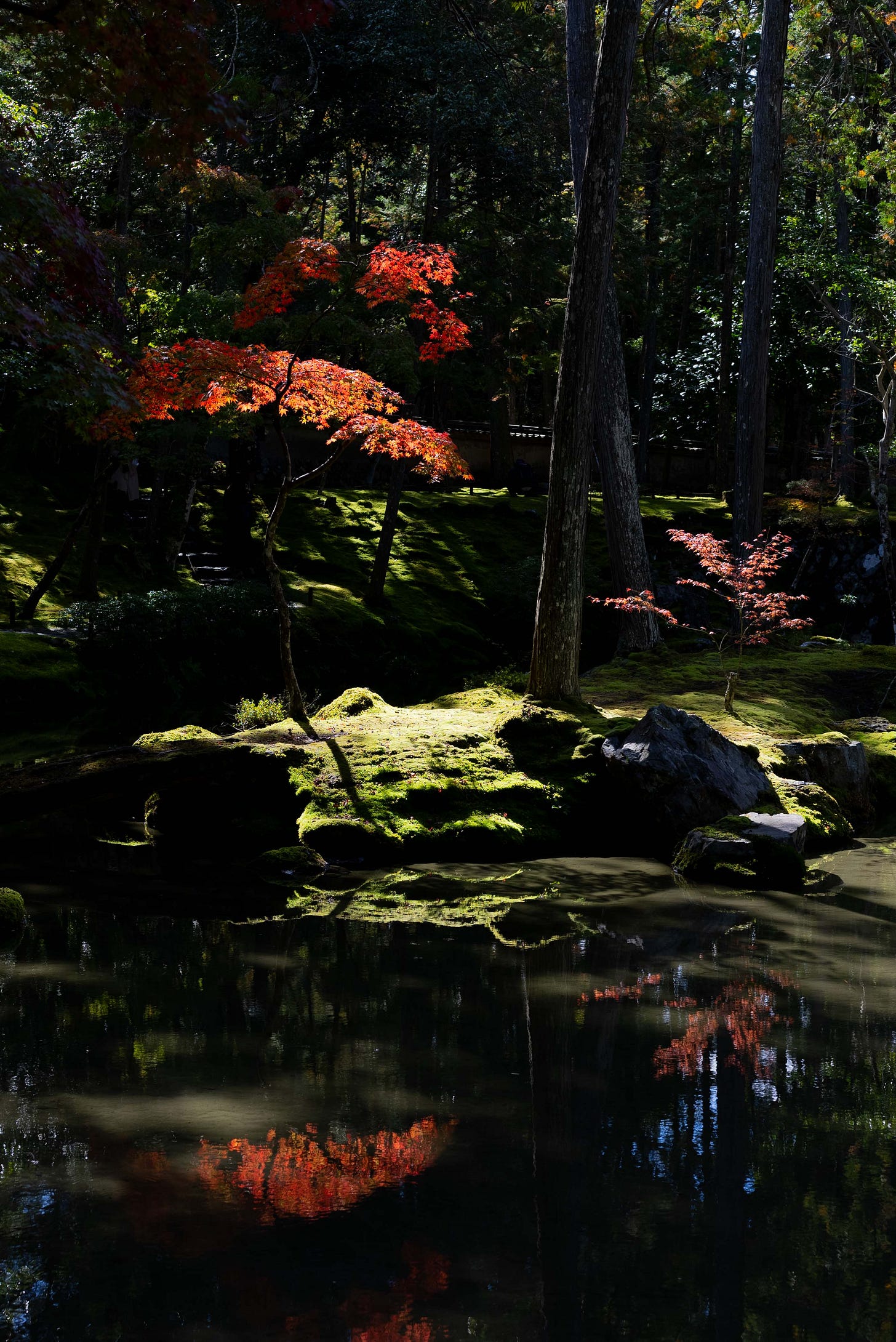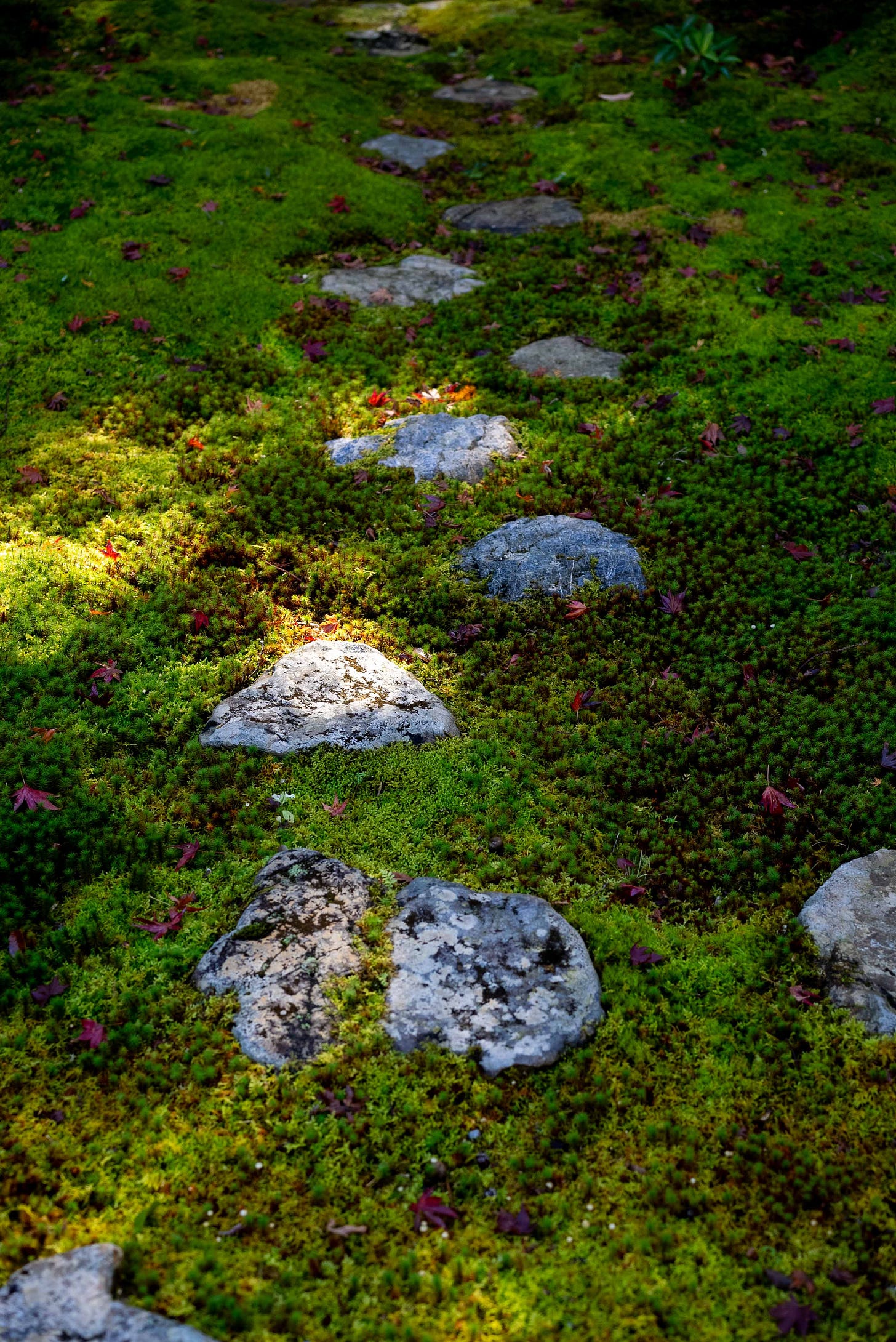JMTS 009: It's Not Easy Being Mossy
Endurance and delight at Kyoto's Saihoji Temple, aka Koke-dera, the Moss Temple
I wasn’t always enchanted by mosses.
As a kid growing up in leafy, shady, suburban Pennsylvania, moss was the enemy. It prevented our family from having a ‘normal,’ grassy front lawn. I remember clear instructions to be careful not to rip it up when raking the leaves, but that was not so much for the sake of the moss as it was not to leave a muddy, bald patch next to the pachysandra.
All of this of this was before I visited Kyoto’s Saihoji Temple, otherwise known as Koke-dera, the Moss Temple, where my feelings about moss were transformed.
___
There are more than 1600 Buddhist temples in Kyoto, Japan.
And in the month of October 2023 alone, there were more than 2.5 million overseas visitors.
Now you might imagine that if all of those visitors spread themselves out around all of those temples, well, the crowds wouldn’t necessarily be so bad, right?
But of course that’s not what happens. All 2.5 million visitors attempt to visit the same dozen or so of the most famous temples, and the resulting hordes are, in a word, insane. Recently I visited Ginkakuji, widely considered one of Kyoto’s Top Ten Temples, originally designed to serve as a place of rest and solitude for the Shōgun Ashikaga Yoshimasa. After running the souvenir shop gauntlet and standing in line for half an hour to enter the grounds, then shuffling shoulder-to-shoulder down the supposedly meditative garden paths whilst dodging selfie sticks, all I wanted was to get out of there as quickly as possible.
This problem is not new. The dramatic increase in international visitors since Japan reopened in October 2022 has been making the headlines. But overwhelming crowds have plagued Kyoto’s top sights for decades.
Saihoji Temple used to be one of those places. It opened to the public in 1928, and post-WWII its popularity steadily grew. According to Saihoji, at one point it received the fourth-highest number of visitors of all temples in Kyoto.
So in 1977, Saihoji made the bold decision to strictly limit visitors (and forgo the lost revenue from admission fees). To preserve a peaceful atmosphere. To honor its purpose as a Zen Buddhist temple and ‘spiritual home.’ To protect its famous mosses from getting trampled on by wayward tourists.
They instituted a complicated reservation system that required handwritten letters and self-addressed return postcards, all within a very specific window of days prior to the desired date of your visit. It certainly separated the wheat from the chaff. Only the fiercely committed went through the trouble.
But since the pandemic Saihoji has launched a sleek new website and now it is possible to make a reservation for an “Everyday Visit,” or “Nichi-nichi Sanpai,” online. Eureka! The process is fairly straightforward. I registered on the website and made my reservation about a month prior to my visit. (Even earlier is recommended, plans permitting.)
Is restricting access and charging a high admission fee the answer to overtourism? No, not necessarily. But it’s been working for Saihoji Temple for almost 50 years. I was looking forward to finding out what the experience had in store, and crossing my fingers for a little headspace.
___
I’ve been on a city bus for about an hour - traveling through Northwestern Kyoto, crossing the Togetsukyo Bridge in tourist-choked Arashiyama, and ultimately turning south - when I finally arrive at my destination: Saihoji bus stop, the end of the line.
A small group begins to form outside the temple in advance of our strict 10:30 a.m. appointment time. Everyone seems a little anxious, and an older couple who arrived by taxi has a bad case of we-were-here-first-itis. But soon enough we are welcomed inside the gate. Our QR codes are scanned, we each receive a calligraphy pen, and then are directed towards the main hall of the temple.
I take off my shoes and head inside where I’m handed two large pieces of paper: one is an English explanation of the Buddhist practice of sutra copying, or shakyo 写経, the other features the text of the Enmei Jukku Kannon Gyo (Ten Phrase Life-Prolonging Kannon Sutra), written in faint kanji characters meant to be traced over with the aforementioned pen. All visitors to Saihoji Temple are expected to participate in this spiritual practice, a requirement made clear when making reservations.
What is a sutra? A religious teaching or scripture. Sutra copying is a devotional practice, and was once the primary means of disseminating Buddhist teachings. This particular sutra has many interpretations, most simply teaching that all living beings possess the heart of the Buddha.
There are tables and chairs for anyone who prefers not to sit on the floor, but I find a spot at one of the kneeling writing desks on either side of the worship area. The instructions suggest starting by calming the mind, relaxing the body, observing a moment of silence, and taking five deep breaths. Then: “Concentrate on the act of copying the sutra before you, and not on the neatness of your handwriting.” (Whew!) The whole point is to approach the task with mindfulness and reverence. When I look around I see that everyone - except for one indifferent person - is taking it seriously and doing their best to trace the Japanese text.
I’m not Catholic, so I don’t cross myself or light candles when I enter a cathedral. And I don’t practice Shinto so I don’t bow and clap my hands at Shinto shrines. But for some reason, sitting in this sacred hall and copying a religious text I scarcely understand doesn’t trouble me. I have been requested to do so, for starters. And I find myself genuinely moved by the experience — a room of 30 or 40 visitors from Japan and around the world, collectively contemplating, if only for a moment, compassion towards all living things.
Photos (and chatting) are strictly prohibited inside the temple. And while I must admit I’m tempted to sneak a picture (for your benefit, dear reader), I’m feeling glad for the clarity of the injunction. The room is hushed. There’s a shared sense of purpose. And by the end of the practice, we have all settled down. Through the silent copying of sutras, we have quieted our minds and remembered where we are — an actual temple, not a ‘tourist attraction.’
Finally, I exit the main hall and head outside. This is the reason we are all here — to visit the famous garden covered in over 120 different varieties of mosses.
There’s a momentary bottleneck at the entrance as the compulsion to photograph kicks back in. Everybody’s getting in the way of each others’ photos. But since there aren’t that many of us, we spread out fairly quickly. Then the hushed calm established earlier returns.
The central feature of the garden is a pond that is shaped like the Japanese kanji for "heart" and a strolling path that winds around it in a loop. As I reach the pond, I catch my breath, awestruck. It’s that beautiful.
Most Japanse gardens have at least some moss. The island climate and humidity are hospitable to moss growth, and Japan is home to over 2,000 species of mosses. But the garden at Saihoji Temple is unique. Mosses cover the entire garden in a carpet of green. Everywhere you look: mosses.
The history of Saihoji Temple dates back almost 1300 years, and it’s a long and complex story. Originally founded as a temple within the Hosso Sect of Buddhism in 731, it was then converted to the Jodo sect, and later, in 1339, after years of neglect, it was restored as a Zen temple of the Rinzai Sect by high priest and master gardener Muso Kokushi.
The gardens at Saihoji date to this time period. But what I’m surprised to learn is that the lower garden was not blanketed with moss on purpose. It’s not a moss-covered garden by design. No, the moss situation is the result of war, neglect, and multiple floods in the 17th century that deposited fertile soil on the garden, originally made with white sand. Moss grows very slowly. It took more than 100 years from the time of these floods for the entire garden to be covered with mosses.
As I slowly make my way around the garden path, I’m transfixed. The way the colors of the mosses change as the sun ducks in and out from behind the clouds. The strange, spongy texture that makes you want to touch it. Soft, pillowy, blankets of green that evoke primeval forests and seem to tickle some ancient part of my brain.
Mosses date back some 450 million years, they say. They have no roots. They suck up moisture through hairlike structures called rhizoids and from the air and the rain through their highly absorbent surfaces. Then they hang onto the moisture like a sponge, and with that retained water, they stabilize the soil and help other plants to grow.
Gazing at the mosses fills me with the urge to get down on my hands and knees with a magnifying glass, and dive into their complex, enchanted, miniature world. Apparently, I’m not the only one with this impulse. A wildly successful 2011 book called “Mosses, My Dear Friends” by Hisako Fujii sparked a phenomenon: moss-viewing gatherings and rings that sprout moss and an entire subculture of moss-obsessed ‘moss girls.’ I seriously need to devote some more time to looking into this. I really had no idea before now that moss-viewing was a thing.
An hour or so later, I’ve completed my very slow stroll around the garden. I put my camera away, and decide to just be here. I walk the path again. It’s almost closing time, and there are only about 15 people remaining in the entire garden. The light has changed and is illuminating the autumn leaves from behind, like shards in a stained glass window.
The effect of all this moss is incredibly calming. I’m feeling grateful that it takes a fair amount of effort to be here. I’m feeling grateful that my fellow visitors are enjoying it as much as I am. The entire experience feels intentional, respectful, and deeply appreciative. A heightened sense of wonder prevails.
With time, the enduring moss seems to remind us, the world heals.
Saihoji Temple
56 Matsuojingatanicho, Nishikyo Ward, Kyoto, 615-8286, Japan
Reservations: https://intosaihoji.com/en/nichinichi/
Google Maps: https://maps.app.goo.gl/1PybjVsCSS7dq96D8
Access: ~1 hr by Kyoto city bus #73 from Kyoto Station, or 20 min by taxi
JMTS Tip: Don’t miss a quick visit to Jizo-in Temple, aka Take-dera, the Bamboo Temple, a short walk from the Saihoji Bus Stop. Tranquil and serene, with hardly any visitors, the temple is approached through a small bamboo forest.
Most Crowded Temples & Shrines in Kyoto:
Kiyomizu-dera Temple
Fushimi Inari Taisha Shrine
Kinkakuji Temple
Ginkakuji Temple
Ryoanji Temple and Garden
Sanjusangendo Temple
Off-the-Beaten Path Temples & Shrines in Kyoto:
Ōbai-in Temple and other sub-temples at Daitoku-ji
and hundreds more…
Do you have a favorite temple or shrine in Kyoto? Let us know in the comments!
O genki de ne,
Julia Morrison











